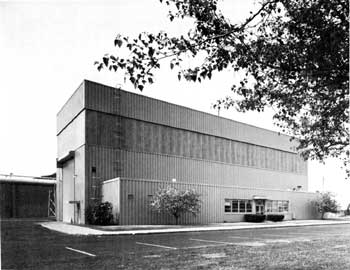.gif)
|
Man in Space
A National Historic Landmark Theme Study |

|
|
Rocket Engine Development Facilities |

Exterior view of Zero-Gravity Research Facility, 1982.
(Courtesy of NASA, NASA/Lewis Research Center Facilities Office)
Zero-Gravity Research Facility
| Name: | Zero-Gravity Research Facility (B-2) |
| Location: | Lewis Research Center, Cleveland, Ohio |
| Owner: | National Aeronautics and Space Administration (NASA) |
| Condition: | Excellent, unaltered, original location |
| Builder/Architect: | NACA |
| Dates: | 1966-Present |
DESCRIPTION
The Zero Gravity Research Facility is at the Lewis Research Center in. Cleveland, Ohio. It is the only know facility of its size in the free world capable of performing tests in a reduced gravity environment. It has successfully supported researchers involved in the Manned Space Program (Mercury, Gemini and Apollo), and the Centaur Program. Most research tests involve behavior of components, systems, liquids, gases, and combustion when under the influence of reduced gravity or low acceleration environments. [1]
This facility consists of a concrete-lined, 28-foot diameter shaft that extends 510-feet below ground level A steel vacuum chamber, 20-feet in diameter and 470-feet high, is contained within the concrete shaft. The pressure in this vacuum chamber is reduced to 13.3 newtons per square meter (1.3x10-4atm) before use.
The ground-level service building has, as its major elements, a shop area, control room, and a clean room. Assembly, servicing, and balancing of the experiment vehicle are accomplished in the shop area. Tests are conducted from the control room, which contains controls for the "pump down" of the vacuum chamber, the experiment vehicle pre-drop checkout, release and the data retrieval system. Those components of the experiment that are in contact with the test liquid are prepared in the facility's clean room. The major elements of the clean room are an ultrasonic cleaning system and a laminar-flow work station for preparing those experiments requiring more than normal cleanliness.
Mode of Operation
The Zero-Gravity Facility has two modes of operation. One is to allow the experiment vehicle to free fall from the top of the vacuum chamber, which results in a nominal 5.15 seconds of free fall time. The second mode is to project the experiment vehicle upwards from the bottom of the vacuum chamber by a high-pressure pneumatic accelerator on the vertical axis of the chamber. The total up and down trajectory of the experiment vehicle results in a nominal 10 seconds of free fall time.
In either mode of operation, the experiment vehicle falls freely; that is, no guide wires, electrical lines, are connected to the vehicle. Therefore, the only force acting on the freely falling experiment vehicle is due to residual-air drag. This results in an equivalent gravitational acceleration acting on the experiment, which is estimated to be of the order of 10-5 g or better.
Recovery System
After the experiment vehicle has traversed the total length of the vacuum chamber, it is decelerated in a 12-foot diameter, 20-foot deep container which is centered on the vertical axis of the chamber and filled with small pellets of expanded polystyrene. The deceleration rate (averaging 32 g) is controlled by the flow of pellets through the area between the experiment vehicle and the wall of the deceleration container. This deceleration container is mounted on a cart that is retracted prior to utilizing the 10-second mode of operation. In this mode of operation, the cart is deployed after the experimental vehicle is projected upwards by the pneumatic accelerator.
This facility is in active service supporting present space shuttle experiments.
STATEMENT OF SIGNIFICANCE
The Zero-Gravity Facility is significant because it is the only such facility in NASA's inventory that can study the behavior of liquids in a low gravity environment. A knowledge of the characteristics of liquids in a space vehicle is important to design engineers Information concerning liquid sloshing which can change the center of mass of a space vehicle and thus effect vehicle stability and control is absolutely essential to the successful performance of liquid high energy space vehicles such as the Centaur and Saturn upper stages. The study of the effects of liquid sloshing on the performance of upper stage liquid rockets was therefore essential to the successful completion of the objectives of the American Space Program.
The Zero-Gravity Facility is the only such facility of its type in the world and is directly linked to the development of the Centaur and Saturn upper stage rockets, which have transported Americans to the moon and sent American space vehicles such as the Viking, Voyager, and Mariner spacecraft to the planets. Research and data developed here involving the physics of liquids in a zero-gravity environment was indispensible to the successful development of these high energy liquid fueled rockets.
FOOTNOTES
1. The descriptive material in this section was taken from the following source: Thomas Labus, Natural Frequency of Liquids in Annular Cylinders under Low Gravitational Conditions. NASA Technical Note D-5412. (Washington, D.C.: National Aeronautics and Space Administration, September 1969), pp. 22-4.
BIBLIOGRAPHY
Labus, Thomas L. Natural Frequency of Liquids in Annular Cylinders under Low Gravitational Conditions. NASA Technical Note D-5412. Washington, D.C.: National Aeronautics and Space Administration, September 1969.
National Aeronautics and Space Administration. Technical Facilities Lewis Research Center. Cleveland, Ohio: Lewis Research Center, No Date.
National Aeronautics and Space Administration. Zero Gravity Research Facility. Cleveland, Ohio: Lewis Research Center, September 1966.
Petrash, Donald A. and Corpas, Ellias L. Zero Gravity Facility for Space Vehicle Fluid Research. Reprinted from the 1973 Proceedings of the 19th Annual Meeting of the Institute of Environmental Sciences. No place of publication, No date.
PHOTOGRAPHS
(click on the above photographs for a more detailed view)
Last Modified: Mon, Jan 8 2001 10:00:00 am PDT
man-in-space/space6.htm




 Top
Top